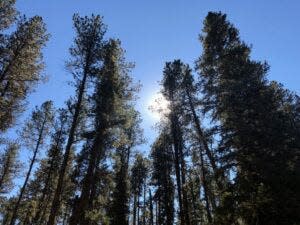Forest Service fixing decades-old blunder in Black Hills
When foresters replanted trees decades ago after a devastating wildfire in the Black Hills, they made a mistake.
They planted a species of ponderosa pine that was not native to the area.
Today, the U.S. Forest Service knows better, but effects linger from the agency’s earlier actions. Thousands of acres in the Black Hills National Forest are covered with deformed, stunted trees that grew from those non-native seeds.
And now, the Forest Service is trying to fix the error.

Forest officials are proposing to cut down thousands of acres of trees just north of Hill City and replant them with native trees over the next several years. The effort is part of a larger movement to ensure forest safety and restoration.
The Artemis Restoration Project, with a name celebrating the historic Artemis rocket launch in November, is the fourth restoration effort in the forest’s Mystic Ranger District – an area roughly comprising the central Black Hills. The projects aim to replant 8,000 to 10,000 acres of forest impacted by the 1939 McVey Fire, which spanned over 20,000 acres and is one of the largest in the forest’s history.
While the replanting effort after the fire was well intentioned, decades later the non-native trees leave the area vulnerable to fires and disease and hurt the quality of wildlife habitat, said Jim Gubbels, district ranger for the Forest Service.
Non-native trees grow deformed, increase fire risk
The originally replanted trees grew stunted and deformed, retaining dead limbs longer than native ponderosa pine. A native ponderosa pine naturally sheds its branches and has a several-foot gap from the ground as it grows, which helps keep fires from spreading to the tree canopy.
None of the originally planted stands are regenerating naturally, and many are infected with gall rust, a disease that grows in a pine tree’s branches or trunk and can be detrimental to young tree growth. The disease is potentially due to the trees’ offsite genetics.
The McVey restoration effort has been in the works since 2019, when groups began developing plans to treat the area.
More:Who takes care of the Sioux Falls area's abandoned cemeteries?
Gubbels expects it’ll be eight to 10 years before native seedlings will be transplanted to the area and grow on their own, given several bidding projects and steps required to cut down trees, collect seeds, grow seedlings, transport them back to the Black Hills and replant the trees.
“The cost of putting a native landscape back together is important work,” Gubbels said. “To the folks around the Black Hills, putting native ponderosa pine back on the ecosystem is a priceless function because that’s habitat and range, and it’s a really important part of the forest.”
Restoration: clearing dead wood, cutting trees, planting new growth
The Artemis project will include a bidding process for loggers to cut down or thin 2,900 acres of the forest. There will also be efforts to save individual, healthy trees; to increase the number of hardwood trees in the area, such as aspen and oak; and to preserve treeless meadows.
The proposed work is similar to other work already occurring in the McVey Fire footprint, including projects named Alvin, Simon and Theodore. Projects have also tackled stacking dead branches on the forest floor into piles for burning to reduce fire risks.
To get the seeds for new trees, the Forest Service will hire tree-climbers to pick pine cones from healthy trees in the forest. Those cones will be shipped to a Forest Service nursery in Nebraska, where the seeds will be extracted, sown and grown until they’re ready to be transplanted.
Although Gubbels didn’t have a specific cost estimate, each project ranges from hundreds of thousands of dollars to up to $1 million. The cost varies depending on the cost of lumber and labor at the time, since the Forest Service can offset its costs by allowing contractors to keep wood removed in the effort.
The USDA Forest Service released a notice of initiation for the Artemis project on Nov. 28. Public comment will be accepted online and through mail up to 60 days after the announcement. Gubbels will make further decisions on the project after another month or two.
“The overall focus here is restoration,” Gubbels said. “In the process, we’re getting a lot of good work out there to reduce fire hazards. The ultimate outcome is that a forest should be in the same shape the rest of the Black Hills is. Long-term, it’ll be a wonderful project.”
Tree lines will remain untouched on the project’s boundaries to retain a visual treeline for private landowners.
Restoration efforts throughout the Black Hills
The Mystic Ranger District isn’t the only area of the Black Hills to engage in restoration efforts.
The Hell Canyon Ranger District in the southern Black Hills has been planting trees throughout the footprint of the historic Jasper fire over the last two decades. The Jasper fire is the largest in the forest’s history, burning more than 83,500 acres in 2000.
The area was so badly scarred that thousands of acres were left without a seed source for mature trees to regrow on their own.
In spring 2021, around 150,000 ponderosa pine seedlings were planted over 400 acres in a portion of the Jasper footprint.
The restoration efforts are needed to ensure the health of the forest.
“If they wouldn’t have replanted any trees, a lot of the area would have seen similar fire scars like Jasper, with no trees left at all,” Gubbels said. “The McVey area would have been a wide-open acreage on the forest not growing trees right now. Those areas could take over 100 years to reseed unless we started replanting.”
This article originally appeared on Sioux Falls Argus Leader: Forest Service fixing decades-old blunder in Black Hills
